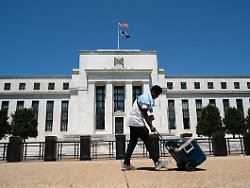Wednesday, November 03, 2021
Fed cuts bond purchases back
US Federal Reserve cuts economic aid
In the Corona crisis, the US Federal Reserve is pumping billions into bond purchases to stimulate the economy. But that is over now. As of this month, the aid programs will be reduced significantly.
In view of high inflation and solid economic growth, the US Federal Reserve is initiating the exit from its enormous aid programs to deal with the Corona crisis. The Federal Reserve (Fed) announced for November that it would reduce its economic asset purchases by $ 15 billion to the current volume of $ 120 billion per month. With the program, the Fed is pumping additional money into the financial markets to keep lending rates low and stimulate the economy.
“The starting shot for the tapering has been given. If everything goes according to plan, it should be finished in mid-2022,” said economist Bastian Hepperle from Bankhaus Lampe. The gradual turning off of the tap means a turnaround in monetary policy. The end of the acquisitions is a prerequisite for an interest rate hike. The monetary authorities left the key interest rate in the range of zero to 0.25 percent. But they already signaled in September that there could be an increase next year.
According to the projections, the key interest rate could rise to one percent by the end of 2023, explains economist Thomas Gitzel from VP Bank: “The Fed seems to be in a hurry. The rapid economic recovery and increased inflation risks are therefore reflected in the intended monetary policy stance. “
“We are currently expecting a first interest rate hike in the fourth quarter of 2022,” said LBBW analyst Elmar Völker. “Should the inflationary pressure remain more persistent than expected, however, both the exit from bond purchases and the path to rising key interest rates could become noticeably shorter.”
End of aid possible as early as June 2022
The monetary policy decisions had been expected in the financial markets, the Fed had already prepared investors accordingly. The tapering of bond purchases is likely to continue gradually in the coming months in the same order of magnitude, so that the program would expire in June 2022. However, the monetary authorities reserve the right to adjust the pace if necessary depending on economic developments. The US stock markets initially reacted calmly to the monetary policy decisions.
The Fed had reacted to the corona crisis with an extreme easing of its monetary policy. But meanwhile the central bank is under pressure to shift down a gear. The US inflation rate rose to 5.4 percent in September and thus reached – as in June and July – the highest level since 2008. Inflation is thus well above the Fed’s target of two percent. In view of high energy prices and persistent supply problems in world trade, it is becoming increasingly clear that increased inflation is not – as the Fed initially assumed – a relatively quickly passing phenomenon.
Meanwhile, the US economy has largely recovered from the crisis. In the summer months, growth lost significant momentum due to supply bottlenecks in the industry and the increasing number of corona cases. But the situation no longer seems critical. For example, job creation in the private sector accelerated unexpectedly in October, according to data from the labor market service provider ADP. The US government’s broader labor market report is eagerly awaited on Friday. In September the US unemployment rate fell to 4.8 percent.
